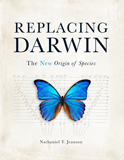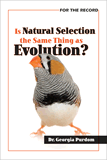
Is Natural Selection at Odds with Creation?
The claim that biblical creationists reject natural selection is based on an outdated notion.
“Do you believe in natural selection? Do you believe that animals and plants change at all?” If you say you believe in creation and a young earth, you’re likely to get questions like this. The young-earth creationist view has been so maligned in popular culture that many people think creationists deny basic facts of life.
Do they? Is natural selection fact, or is it a fantasy invented by Charles Darwin? Should Bible-believing Christians reject change in nature as a lie?
Unfortunately, many non-creationists base their answers to these questions on outdated views of creationist thinking. Consult modern biology textbooks or popular books on evolution, and you’ll likely find a description of creationism that is more than 150 years old. Contemporary attitudes toward creation are anything but modern.
Mistaken Thinking About Species
The reasons for this misunderstanding go back to the 1700s. In 1735 Carl Linnaeus gave us the formal scientific description of life—the binomial system of classification (genus and species). When scientists use the term species today, they are using Linnaeus’ concept. Since Linnaeus’ concept of species is only a few hundred years old, the formal scientific debate over the origin of species is equally recent.
The 1700s’ explanations for the origin of plants and animals reflected the limits of the budding science of the day. For example, when Linnaeus published the 10th edition of his classification scheme in 1758, he knew of fewer than 200 mammal species. Today, we know of more than 5,400. Knowledge of the biological world was extremely limited in Linnaeus’ day.
Despite this dearth, pre-Darwin scientists began to see patterns they thought could help explain the origin of plants and animals. They noted that animals were well suited to the environments in which they lived. For example, polar bears’ thick white coats help camouflage and insulate them in the frigid, snowy Arctic. Farther south, in the US Rocky Mountain ranges, bears’ coats are black, not white. Again, camouflage seems to be one reason behind this pattern. Species are good fits for their natural environments. In fact, species seem to be designed for the environments in which they live.
Taken at face value, this observation of “design” seems to have two profound implications. First, if species are designed for the habitats in which they reside, it would seem they have always been in those locations. Second, if each individual species has always been in its current location and fits it very well, then its specific traits did not come from a universal common ancestor at another location. Rather, it would seem that a master Designer placed them in their locations at the beginning—which further indicates that each species is unrelated to others.
Charles Darwin directly refuted this popular (and incorrect) view of the origin of species—that species were created separate and distinct from other species. Since Darwin replaced the creationist ideas of his day with his views based on adaptation, natural selection, and biological change, it’s easy to see why the stereotype that “creationists don’t believe in biological change” persists.
The Bible and the Origin of Species
But modern creationists believe very differently from the creationists of 1859. We reject the idea that species have always been in their current locations. And we recognize that many species are related to one another.
Why? What has changed since 1859?
Did you notice that the 1700s’ views were not based on any specific Scripture passages? In fact, they completely ignored what the Bible says plainly about the spread of animals over the earth.
Genesis 1 documents that God created creatures according to what Genesis calls their min, not the man-made category known as species.
What does the Bible actually say about the origin of species? Since the Bible was written thousands of years before Linnaeus, the original Hebrew and Greek texts did not include the word species. Instead, Genesis 1 documents that God created creatures according to their min, not species (min is the English transliteration of the Hebrew word normally translated as kind). In Genesis 6, God commanded Noah to take male and female of each land-dwelling, air-breathing min aboard the ark. Genesis 7 tells us why—to repopulate the world after the flood.
These clues suggest that min can be identified by breeding two individuals. If they successfully produce offspring, they’re part of the same min.
Our current knowledge of successful animal crosses indicates that min and species are not the same thing. In fact, the next higher level of classification in the Linnaean system—genus—also does not seem to correspond to min. Instead, the level of family appears to be the best approximation. For example, all cat species—lions to housecats—belong to the same family. They’re part of the same min.
This conclusion has profound ramifications. Since Noah took only two of the cat min aboard the ark, the 30-plus species of cats alive today have formed since the flood. How? Via adaptation, natural selection, and biological change. This is the modern creationist view.
Does that mean creationists agree with Darwin after all? Well, if recognizing that natural selection happens means agreeing with Darwin, then the answer is a qualified yes. God designed creatures with the marvelous ability to adapt to different environments as they spread out to fill the earth. Species can change; in fact, they do so surprisingly quickly. But one min cannot change into another min.
Related Videos
Is Natural Selection the Same Thing as Evolution?
Answers Magazine
March–April 2018
The beach beckons us with its seashells. More than just ornate collectables, they testify to the Creator’s lavish provision for even the lowliest creatures. The Creator designed shells with mind-boggling features evolution can’t begin to explain.
Browse Issue SubscribeRecommended Resources

Answers in Genesis is an apologetics ministry, dedicated to helping Christians defend their faith and proclaim the good news of Jesus Christ.
- Customer Service 800.778.3390
- © 2024 Answers in Genesis






